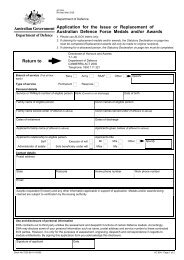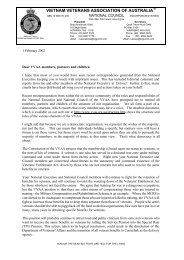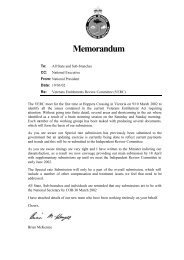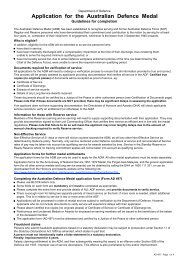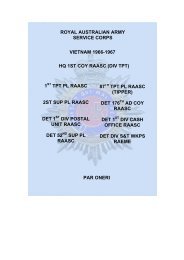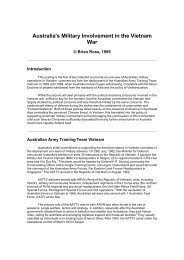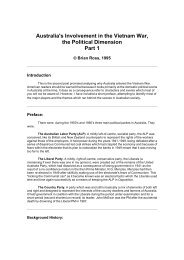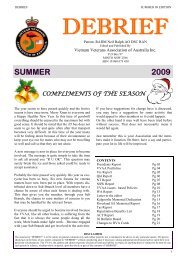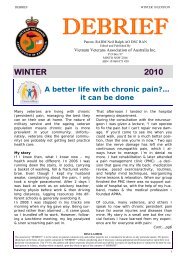TPI Model Explainatary Memo
TPI Model Explainatary Memo
TPI Model Explainatary Memo
You also want an ePaper? Increase the reach of your titles
YUMPU automatically turns print PDFs into web optimized ePapers that Google loves.
<strong>Memo</strong>randum<br />
To: All State and Sub-branches<br />
CC: National Executive<br />
From: National President<br />
Date: 21/08/01<br />
Re: Special Rate Submission<br />
As a result of queries from those external to our Association and some members that<br />
clearly have not been party to the mechanics surrounding our submission to government<br />
on the Special rate issue, I offer the following additional information about our model<br />
with a short update on the current state of play.<br />
The VVAA is the only ESO at this time that did the mathematical and intellectual rigor in<br />
its submission. It is the only ESO who put a discussion paper out for critical analysis by<br />
its members and others. It did the numbers and explained its assumptions. I note no other<br />
submissions from any other ESO's that detail figures or how they arrived at their<br />
assumptions.<br />
Let me put some of these assumptions into perspective and you will see the thinking<br />
behind the development of our submission.<br />
There are those that tell us that certain public servants and politician's pay are indexed<br />
against the MTAWE. This is not correct. The only pensions benchmarked/indexed to<br />
the MTAWE are the age pension at 20% and War Widows pensions, at 26%. That's<br />
it.<br />
The MTAWE is a notional statistical figure that measures the average total male<br />
average wage; it fluctuates regularly according to an average. That average is made up<br />
of wage rises, negotiated or bargained, price of Australian dollar and other economic<br />
indicators that fluctuate through the year. The real consistent value is the CPI, which<br />
is used as an indexing methodology in regard to all pensions and gratuities other than<br />
the <strong>TPI</strong> rate, and War Widows supplement.<br />
To benchmark against the MTAWE is like fixing your rate to the rise and fall of a<br />
temperature gauge, it fluctuates widely in any one quarter.
21 August 01<br />
The reality is that there is a budget that is determined by elected government at the<br />
time and our portion is given with expedience of political realities as against the<br />
platitudes abundantly heaped upon us.<br />
With this in mind what the VVAA has set out to do was to have a model accepted.<br />
That model indexed to a fixed negotiated wage that was reviewable from time to<br />
time. It takes into consideration the calculations that needed to be inclusive in a<br />
percentage variable when the payment was for the natural life of the veteran.<br />
Our model is flexible in regard to negotiation strategy and includes an indexing to<br />
CPI/MTAWE reviews. Has a non-economic component that is also indexed to<br />
CPI/MTAWE reviews that over a period of eighteen months restored the erosion<br />
figure incurred over the past twenty years and maintained its value.<br />
Like any document that impacts so much on vulnerable veterans the document and<br />
model is a "living document" not set in stone but giving the flexibility to negotiate<br />
and position ourselves in a win/win position.<br />
It is not the perfect solution? far from it, but it is a real well thought out paper that can<br />
stand up to critical analysis and importantly it does not paint us into a corner unlike<br />
other submissions.<br />
Example of MTAWE weakness, say we benchmarked the <strong>TPI</strong> pension to 55% of the<br />
MTAWE, there is a rise or fall in the CPI the MTAWE fluctuates at times up and<br />
other times down, the payment extrapolated can in affect cause a decrease against the<br />
negotiated or bargain wage which are real monetary figures and are registered with<br />
IRC. ACBW is tangible the MTAWE is not.<br />
Then one has to take in the political realities and all the platitudes or motherhood<br />
words uttered are not going to change that!<br />
We believe that the $665m extra dollars to fund the MTAWE model is not going to<br />
wash what ever political party you back. A rise of $445 per fortnight creates unreal<br />
expectations within the <strong>TPI</strong> community. Include the $86,000 loan option with 50% of<br />
<strong>TPI</strong> taking up the offer puts the three-year budgetary impost at $1.7bn. If you believe<br />
that any government is going to go along with this, no matter how deserved it may be,<br />
I suggest you go down and talk to the fairies at the bottom of your garden.<br />
We have been criticized that our figures are way out in regard to the other<br />
submissions but since those doing the critizing offer no figures to understand their<br />
reasoning we can only do our own analysis.<br />
We do not see this as a competition to see who can out do who, what we put forward<br />
is a realistic economical and political document that presents a model that can be<br />
negotiated and if need be increase the bottom line. Our aim is to Claw back the<br />
erosion and index the <strong>TPI</strong> to a real monetary figure.<br />
One ignorant individual with an axe to grind has even accused the VVAA members of<br />
collusion with the government and the Minister. A bloody insult to say the least.<br />
2
21 August 01<br />
Some have even employed spoiling tactics with our submission purely because our<br />
bottom line figure of $60.75 using 60% of the ACBW is too low to claw back the<br />
erosion. In reality, both figures are variable and gives the VVAA some bargaining<br />
power. Something we will need when dealing with DVA and the government.<br />
While the ACBW is relative new indexing of wage movement, it's a real monetary<br />
figure, is registered with the Industrial Relations Commission (IRC) and can be<br />
indexed in net terms against the MTAWE and CPI. As it states on the cover sheet of<br />
our Submission our model is 'A Fresh Approach', its also flexible and we leant a<br />
lesson years ago that we do not have our eggs in one basket.<br />
Current Situation<br />
As you are aware we sent our submission to government on 2 July 01 I am happy to<br />
report that there are some very positive signs coming from Government, Opposition<br />
and other ESO's. The latest being a letter from the Minister that supports the VVAA's<br />
approach for ESO's to get together to identify a common approach to government.<br />
As an Association we remain focussed on the aims of our submission. To establish a<br />
joint working party with representatives from Ex-service Organisations and the<br />
Department of Veterans Affairs to determine an agreed the level of erosion of special<br />
rate payments. To identify an effective model whereby the payment can be revisited<br />
and reviewed from time to time to ensuring the living standards of the recipients of<br />
Special Rate payments are maintained.<br />
The VVAA intends to continue to provide a solid leadership role in this process and<br />
just maybe some individuals in other ESO's will see that the solution to the problem is<br />
in the ESO's working together for the common good of their membership…<br />
I feel the solution to the current impasse is near and just maybe it’s a combination of<br />
the 'good points' identified in each model and submission. I feel there are good tidings<br />
in the wind.<br />
Be in touch as more information comes to hand!<br />
3



